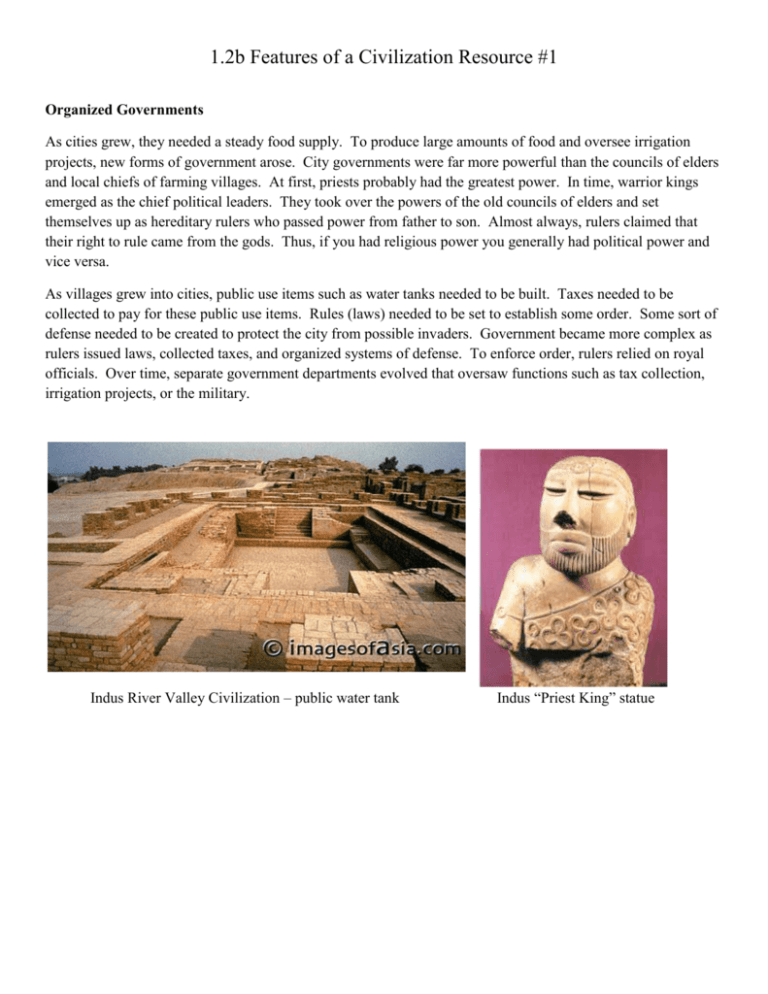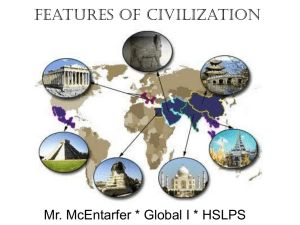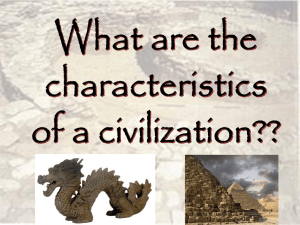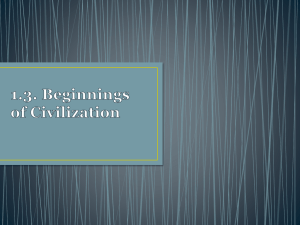1.2b Features of a Civilization Resource #1 Organized Governments
advertisement

1.2b Features of a Civilization Resource #1 Organized Governments As cities grew, they needed a steady food supply. To produce large amounts of food and oversee irrigation projects, new forms of government arose. City governments were far more powerful than the councils of elders and local chiefs of farming villages. At first, priests probably had the greatest power. In time, warrior kings emerged as the chief political leaders. They took over the powers of the old councils of elders and set themselves up as hereditary rulers who passed power from father to son. Almost always, rulers claimed that their right to rule came from the gods. Thus, if you had religious power you generally had political power and vice versa. As villages grew into cities, public use items such as water tanks needed to be built. Taxes needed to be collected to pay for these public use items. Rules (laws) needed to be set to establish some order. Some sort of defense needed to be created to protect the city from possible invaders. Government became more complex as rulers issued laws, collected taxes, and organized systems of defense. To enforce order, rulers relied on royal officials. Over time, separate government departments evolved that oversaw functions such as tax collection, irrigation projects, or the military. Indus River Valley Civilization – public water tank Indus “Priest King” statue 1.2b Features of a Civilization Resource #2 Complex Religions Like their Stone Age ancestors, most ancient people were polytheistic, that is, they believed in many gods. People appealed to sun gods, river goddesses, and other spirits that they believed controlled natural forces. Other gods were thought to control human activities such as birth, trade, or war. In ancient religions, priests and worshippers sought to gain the favor of the gods through complex rituals such as ceremonies, dances, prayers, and hymns. To ensure divine help, people built temples and sacrificed animals, crops, or sometimes other humans to the gods. Sacrifices and other ceremonies required the full-time attention of priests, who had special training and knowledge. The main pyramid at Chichen Itza is a stepped platform with Kukulcan's temple at the top. Religious ceremony/dance in an ancient civilization 1.2b Features of a Civilization Resource #3 Job Specialization The lives of city dwellers differed from those of their Stone Age ancestors. Urban (city) people developed so many new crafts that a single individual could no longer master all the skills needed to make tools, weapons, or other goods. For the first time, individuals began to specialize in certain jobs. Some became artisans, or skilled craftworkers, who made pottery of finely carved or woven goods. Metalworking was another important new skill developed. People learned to make tools and weapons, first out of copper, then later out of bronze (copper and tin mixed). Cities had specialists, too. Bricklayers built city walls. Soldiers defended them. Merchants sold goods in the marketplace. Singers, dancers, and storytellers entertained on public occasions. Such specialization made people dependent on others for their various needs. 1.2b Features of a Civilization Resource #4 Cities Cities rose independently in the valleys of the Tigris and Euphrates rivers in the Middle East, the Nile River in Egypt, the Indus River in India, and the Yellow River, Huang He, in China. Conditions in these river valleys favored farming. Flood waters spread silt across the valleys, renewing the soil and keeping it fertile. The animals that flocked to the rivers to drink the water provided another source of food. In addition, the rivers provided a regular water supply and a means of transportation. Unlike the civilizations in Asia, Africa, and Europe, civilizations in the Americas did not rise in river valleys. Two major civilizations, the Aztecs and Incas, eventually emerged in the highlands of Mexico and Peru. Ancient cities were frequently surrounded by high walls (protection from enemies and flood waters). Early cities boasted large temples and palaces and broad avenues used for public ceremonies. Still, most city streets were narrow and tangled, with houses as small as village huts. Artist re-creation of what Euphrates would look like from an aerial view 1.2b Features of a Civilization Resource #5 Social Classes In cities, social organization became more complex. People were ranked according to their jobs. Such ranking led to the growth of social classes. Priests and nobles occupied the top level of an ancient society. Next came a small class of wealthy merchants (buy/sell stuff), followed by artisans (skilled craftworkers that made pottery, wove things, or made tools/weapons). Below them stood the vast majority of people, peasant farmers who lived in the surrounding villages and produced food for the city. Slaves occupied the lowest social level (bet you are not surprised by this). Slaves sometimes came from poor families who sold themselves into slavery to pay their debts. Others were prisoner captured in war. Because male captives were often killed, women and children made up the largest number of slaves. 1.2b Features of a Civilization Resource #6 Arts and Architecture The arts and architecture of ancient civilizations expressed the beliefs and values of the people who created them. Temples and palaces dominated the city scenery. Such buildings reassured people of the strength and power of their government and religion. Skilled workers built and decorated massive buildings. In museums today, you can see statues of gods and goddesses, temple or palace wall paintings, and furniture and jewelry found in ancient tombs from around the world. They give ample evidence of the artistic genius of the first civilizations. Ancient religious statue Egypt (ancient civilization) Collage of ancient civilization art and architecture 1.2b Features of a Civilization Resource #7 Public Works Closely linked to temples and palaces were vast public works that strong rulers ordered to be built. Such projects included irrigation systems, roads, bridges, and defensive walls (usually made out of brick or stone). Although they were costly in human labor and even lives (there weren’t hard hats or safety harnesses at this time…and they had to build the walls really high to stop the city from being invaded). Public works projects were meant to benefit the city, protect it from attack, and ensure its food supply. Painting of an ancient civilization irrigation system Defensive walls of an ancient Chinese city 1.2b Features of a Civilization Resource #8 Writing A critical new skill developed by the earliest civilizations was the art of writing. It may have begun in temples, where priests needed to record amounts of grain collected, accurate information about the seasons, and precise rituals and prayers. Archaeologists have found masses of ancient writings, ranging from treaties and tax records to business and marriage contracts. The earliest writing was made up of pictograms, or simple drawings that looked like the objects they represented. In time, symbols were added. They might stand for sounds of words or for ideas that could not be expressed easily in pictures. As writing grew more complex, only specially trained people called scribes learned to read and write. Scribes were educated in temple schools and kept records for priests, rulers, and merchants. In only a few societies were women permitted to attend temple schools. As a result, women were generally excluded from beginning scribes, an occupation that could lead to political power. Indus River Valley writing seal (like a stamp) Ancient Egyptian writing carved on bone by ancient Chinese civilization (Shang dynasty)







